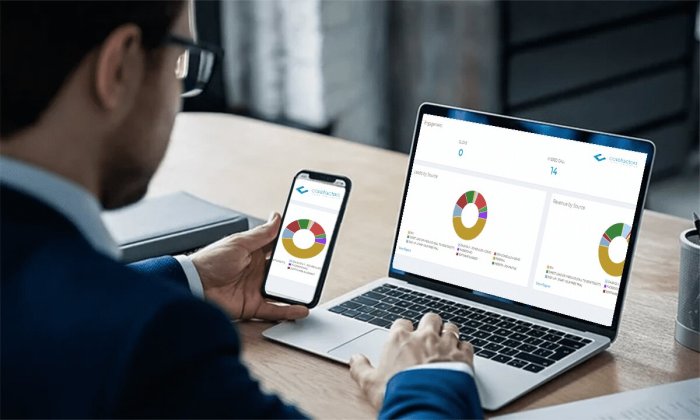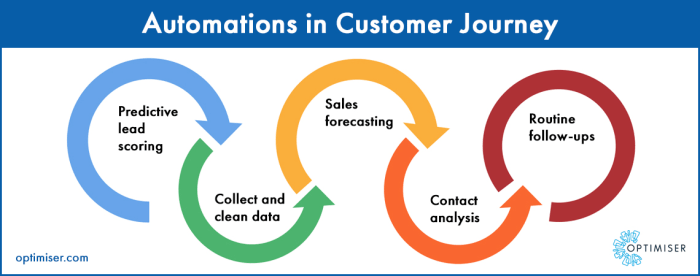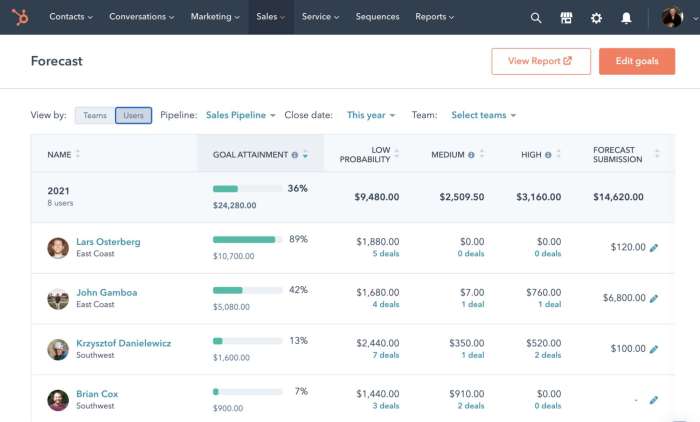CRM software for sales forecasting and revenue tracking is crucial for modern businesses aiming for sustainable growth. This powerful combination allows companies to not only understand past performance but also predict future sales, optimize resource allocation, and ultimately, boost profitability. By integrating sales data with forecasting models, businesses gain valuable insights into market trends, customer behavior, and sales team effectiveness, leading to more informed decision-making and improved strategic planning.
This detailed exploration delves into the key features, benefits, and implementation considerations of such integrated CRM systems.
Understanding how to effectively leverage CRM software for sales forecasting and revenue tracking involves a multi-faceted approach. This includes selecting the right CRM platform, implementing appropriate forecasting methodologies, and establishing robust revenue tracking mechanisms. Furthermore, successful integration with other business systems is paramount for ensuring data accuracy and efficiency. This guide aims to provide a comprehensive overview of these processes, enabling businesses to harness the full potential of this powerful technology.
CRM Software for Sales Forecasting and Revenue Tracking
Effective sales forecasting and revenue tracking are crucial for business success. A Customer Relationship Management (CRM) system, when properly implemented, can significantly enhance these processes. This article explores how CRM software facilitates accurate sales predictions, efficient revenue monitoring, and ultimately, improved business decision-making.
Introduction to CRM Software for Sales Forecasting and Revenue Tracking

CRM software is a centralized system designed to manage all aspects of customer interactions and data. Core functionalities include contact management, lead tracking, sales pipeline management, and reporting. Sales forecasting involves predicting future sales revenue based on historical data, market trends, and other relevant factors. Revenue tracking monitors actual revenue generated against forecasted figures. Integrating CRM with sales forecasting and revenue tracking capabilities provides a unified platform for managing the entire sales cycle, from initial contact to final revenue realization.
The integration of CRM with sales forecasting and revenue tracking benefits businesses by providing a holistic view of sales performance, enabling proactive adjustments to sales strategies, and facilitating data-driven decision-making. Businesses that particularly benefit include those with large sales teams, complex sales cycles, or a need for precise revenue projections. Companies in industries with predictable sales patterns, such as subscription-based services or retail, also gain significant advantages.
| Business Type | Benefits | Challenges | Solutions |
|---|---|---|---|
| Subscription-based SaaS company | Accurate churn prediction, optimized pricing strategies, improved customer retention | Predicting customer churn accurately, managing diverse subscription tiers | Implementing predictive analytics within the CRM, segmenting customers based on subscription type and behavior |
| Retail business with multiple locations | Real-time sales tracking across all locations, identification of top-performing products and locations, optimized inventory management | Data consolidation from multiple sources, ensuring data accuracy across locations | Integrating POS systems with the CRM, implementing robust data validation procedures |
| Large enterprise with a complex sales process | Improved sales pipeline visibility, accurate forecasting of large deals, better resource allocation | Managing a large volume of sales data, coordinating efforts across multiple sales teams | Utilizing advanced CRM features like sales pipeline analytics and collaboration tools, implementing a centralized data repository |
Key Features of CRM Software for Sales Forecasting, CRM software for sales forecasting and revenue tracking
Essential features for accurate sales forecasting within a CRM include historical sales data analysis tools, customizable forecasting models, and integration with external data sources. Various forecasting methods are implemented, each with its strengths and weaknesses. Moving average methods utilize the average of past sales data to predict future sales, while exponential smoothing assigns greater weight to more recent data.
More sophisticated techniques, like ARIMA modeling, might also be available depending on the CRM system.
The choice of forecasting technique depends heavily on the sales environment. For stable sales patterns, moving averages may suffice. However, for volatile markets, exponential smoothing or more complex models are generally more appropriate. Historical sales data forms the foundation of any forecast, but integrating market trends and economic indicators adds valuable context and enhances predictive accuracy. For instance, seasonal fluctuations, economic downturns, or competitor actions can significantly impact sales projections.
Revenue Tracking and Reporting Capabilities in CRM Systems

Effective revenue tracking within a CRM relies on features that automatically capture sales data, integrate with payment gateways, and provide comprehensive reporting functionalities. The system should facilitate the generation of various reports, offering granular insights into sales performance. For example, reports can show sales by region, product performance, and individual sales representative productivity. These insights are crucial for identifying areas of strength and weakness, informing strategic decisions, and driving sales improvements.
Dashboards are key for visualizing revenue data. Effective dashboards provide at-a-glance views of key performance indicators (KPIs), such as total revenue, sales growth rate, and average deal size. They should be customizable to reflect specific business needs and preferences. Regular monitoring of these dashboards enables timely identification of potential issues and allows for proactive intervention.
| Date Range | Revenue | Cost of Goods Sold | Profit Margin |
|---|---|---|---|
| Q1 2024 | $1,000,000 | $600,000 | 40% |
| Q2 2024 | $1,200,000 | $700,000 | 42% |
Integration with Other Business Systems

Integrating the CRM with other business systems, such as Enterprise Resource Planning (ERP) systems and marketing automation platforms, is crucial for maximizing efficiency and data accuracy. Seamless data flow between these systems eliminates data silos, preventing inconsistencies and improving the overall accuracy of sales forecasting and revenue tracking. This integration provides a single source of truth for all customer-related data, enabling better collaboration and informed decision-making.
Challenges in integration can include data format discrepancies, differing system architectures, and the need for specialized integration tools. Solutions involve utilizing application programming interfaces (APIs) or employing integration platforms to bridge the gap between systems. Successful CRM integrations often lead to improved sales performance, streamlined operations, and enhanced customer experience.
- A company integrating its CRM with an ERP system saw a 15% improvement in sales forecasting accuracy.
- A marketing automation integration resulted in a 20% increase in lead conversion rates for a B2B SaaS company.
Choosing the Right CRM Software
Selecting the right CRM involves careful consideration of several factors, including the size and complexity of the business, the specific needs for sales forecasting and revenue tracking, and the budget. Different CRM vendors offer varying features and functionalities, ranging from basic contact management to sophisticated AI-powered predictive analytics. A thorough evaluation of different vendors’ offerings is crucial to finding the best fit for the business.
The implementation process involves careful planning, data migration, user training, and ongoing system maintenance. Assessing the return on investment (ROI) requires quantifying the improvements in sales forecasting accuracy, revenue tracking efficiency, and overall business performance. This can be achieved by comparing key metrics before and after CRM implementation.
Data Security and Privacy Considerations
Data security and privacy are paramount in CRM systems, given the sensitive customer data they store. Compliance with regulations such as GDPR and CCPA is mandatory. Robust security measures, including data encryption, access controls, and regular security audits, are essential to protect customer data. Implementing a comprehensive data backup and disaster recovery plan ensures business continuity in case of data loss or system failure.
Regular employee training on data security best practices is crucial. This includes educating employees on safe data handling procedures, password management, and recognizing phishing attempts. A layered security approach, combining technological and procedural safeguards, is the most effective way to protect sensitive customer information within the CRM system.
Final Review
In conclusion, implementing CRM software specifically designed for sales forecasting and revenue tracking offers significant advantages for businesses of all sizes. By leveraging the insights derived from accurate forecasting and comprehensive revenue tracking, organizations can optimize their sales strategies, improve resource allocation, and enhance overall profitability. The key lies in choosing the right CRM solution, integrating it effectively with other business systems, and adhering to best practices for data security and privacy.
This strategic approach enables businesses to navigate the complexities of the modern market with confidence and achieve sustainable growth.
Query Resolution
What are the common pitfalls to avoid when implementing a CRM for sales forecasting?
Common pitfalls include inaccurate data input, insufficient training for users, neglecting regular data cleansing, and failing to integrate the CRM with other essential business systems.
How can I ensure data accuracy in my sales forecasts?
Data accuracy hinges on regular data cleansing, validation of input data, and using multiple forecasting methods for comparison and validation. Regularly reviewing and updating forecasting models is also crucial.
What are the key metrics to track in revenue reporting?
Key metrics include total revenue, revenue by product/service, revenue by region/sales rep, customer lifetime value (CLTV), and cost of goods sold (COGS) to calculate profit margins.
How often should sales forecasts be updated?
The frequency depends on your business and industry. Monthly or quarterly updates are common, but more frequent updates (weekly) might be necessary for businesses with rapidly changing sales cycles.
